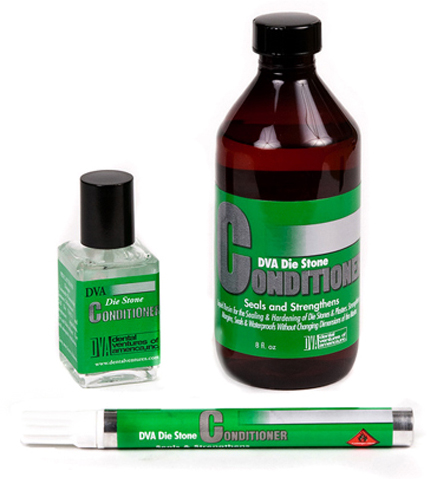DIE STONE CONDITIONER
Description & Application
DVA DIE STONE CONDITIONER is a liquid resin, gypsum sealing and hardening material for models and dies. It is available in either a felt-tipped PEN or BOTTLE with a brush applicator. The availability of both Conditioner and Separator in felt-tipped pens as well as “brush and bottle” configurations is simply to satisfy customers’ differing preferences. Both work equally well.
A DVA CONDITIONER THINNER is available to maintain the proper viscosity of the CONDITIONER.
DIE STONE CONDITIONER is a product that would be used after any die treatment by Zapit and prior to applying Die Spacer. When applied to a gypsum surface, the Die Stone Conditioner penetrates into the porosities of the material. As the carrier evaporates, the resin-like material hardens and provides a sealing layer over the entire area to which it has been applied. As a result, all porosities are filled and considerable strength and increased abrasion resistance is imparted upon the gypsum surface.
Conditioner THINNER is used to maintain the proper viscosity of the CONDITIONER.
Product Benefits
- Strengthens dies & Increases die abrasion resistance
- Reduces chipping of margins
- Improves wax adaptation & marginal fit
- Eliminates flaking of die spacer
- Eliminates ‘flaking’ of die spacer
- Simplifies application techniques
- Extremely Economical
Product Features
- Adds a hardened resin coating
- Penetrates and fuses the stone granular structure.
- Hardens dies without adding thickness to the die or marginal areas.
- Forms a chemical bond with DVA Die Spacer
- Chemically bonds with DVA Die Spacer.
- Available in either Pen or Brush applicator systems, whichever is preferred.
- 8-oz. Refill Bottles Available
Die Treatment System
Tech Tips & Product Maintenance
- DRILLING UNIFORM HOLES: Drill each hole with a consistent speed and pressure on the drilling table, making certain to drill each hole at least two or three times in rather quick succession. The theory is the first drilling makes the hole, the second refines the hole size and shape, and the third time removes any debris.
- MARKING PIN LOCATIONS: The new Alignment Fixture eliminates the need to pre-mark the pin locations with a marking pen prior to drilling. Contact DVA for information and instructions.
- PROPER PIN INSERTION PRESSURE: Excessive pressure in the seating of each dowel pin into the drilled hole will result in undesirable frictional retention when the poured stone locks the two pins together. Light pressure is all that is required on each pin to create a stable die that is easily seated and removed.
- STABILITY for LARGE, MOLAR DIES: Additional stability in large molar dies or a last molar contact tooth may be achieved by placing three dowel pins in a triangle fashion within the molar component. Placing only two pins in a mesial, distal pattern will also aid in stability.
- SMALL ANTERIOR DIES: When the die size prevents the placement of two pins, simply drill only one hole per die. Using a small, round or inverted cone burr cut groves in the base directly behind the drilled hole creating an anti-rotational notch into which the the poured stone can be keyed.

